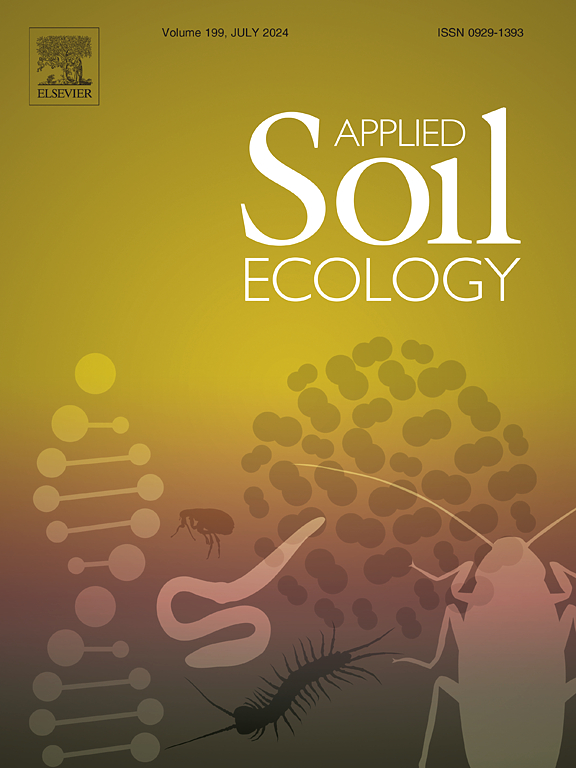Mechanistic insights into lead uptake and immobilization mediated by soybean biochar and arbuscular mycorrhizal fungi in Bidens parviflora
IF 5
2区 农林科学
Q1 SOIL SCIENCE
引用次数: 0
Abstract
Arbuscular mycorrhizal fungi play a critical role in promoting plant nutrient acquisition, enhancing stress tolerance, and maintaining soil health. However, their interaction with soybean-derived biochar (SBC) under lead (Pb) stress remains inadequately explored. This study investigated the combined effects of Funneliformis mosseae inoculation and SBC application on the growth, photosynthetic performance, and chlorophyll content of Bidens parviflora in Pb-contaminated soil. A pot experiment was conducted with eight treatments: control; (T1) SBC; (T2) AMF; (T3) SBC + AMF; (T4) Pb; (T5) Pb + SBC; (T6) Pb + AMF; and (T7) Pb + SBC + AMF. With Pb treatments, T7 significantly improved shoot and root biomass by 27 % and 11 %, respectively, compared to T4. Photosynthetic parameters net photosynthetic rate, stomatal conductance (Gs), and transpiration rate (Tr) were also enhanced by 24 %, 61 %, and 49 %, respectively. Soil urease and phosphatase activities along with AMF colonization were increased by 48 %, 44 %, and 48 % relative to T4. Without Pb treatments, T3 led to significant increase in shoot and root biomass by 38 % and 24 %, respectively, compared to CK. Pn, Gs, and Tr improved by 24 %, 48 %, and 54 %, respectively, while urease and phosphatase activities, and AMF colonization were increased by 42 %, 37 % and 65 % over the CK treatment. Structural equation modeling (SEM) revealed that (SBC + AMF + Pb) treatment enhanced nutrient uptake (shoot R2 = 0.851; root R2 = 0.805) and soil enzyme activity (R2 = 0.774), highlighting their synergistic role in mitigating Pb stress. In conclusion, Treatments T3 and T7 demonstrated a significant enhancement in both plant performance and soil function. These findings highlight the potential of the synergistic interaction between AMF and biochar as a sustainable strategy for remediating Pb-contaminated soils and promoting sustainable agriculture.

大豆生物炭和丛枝菌根真菌介导的铅吸收和固定机制研究
丛枝菌根真菌在促进植物养分获取、增强抗逆性和维持土壤健康等方面发挥着重要作用。然而,在铅(Pb)胁迫下,它们与大豆衍生生物炭(SBC)的相互作用尚未得到充分研究。本研究研究了在铅污染土壤中,接种moseforis和施用SBC对小花Bidens parviflora生长、光合性能和叶绿素含量的联合影响。盆栽试验设8个处理:对照;南方浸信会(T1);AMF (T2);(t3) sbc + amf;(T4)铅;(T5) Pb + SBC;(T6) Pb + AMF;(T7) Pb + SBC + AMF。在Pb处理下,T7处理的地上部和根部生物量比T4分别提高了27%和11%。净光合速率、气孔导度(Gs)和蒸腾速率(Tr)也分别提高了24%、61%和49%。土壤脲酶和磷酸酶活性随AMF定殖而相对于T4分别提高了48%、44%和48%。未加铅处理下,T3处理的地上部和根部生物量较对照分别显著增加38%和24%。与对照相比,Pn、Gs和Tr分别提高了24%、48%和54%,脲酶和磷酸酶活性和AMF定殖分别提高了42%、37%和65%。结构方程模型(SEM)显示,(SBC + AMF + Pb)处理提高了植物对养分的吸收(地上部R2 = 0.851;根系R2 = 0.805)和土壤酶活性(R2 = 0.774),表明它们具有协同缓解铅胁迫的作用。综上所述,T3和T7处理均显著提高了植物生产性能和土壤功能。这些发现突出了AMF和生物炭之间的协同作用作为修复铅污染土壤和促进可持续农业的可持续战略的潜力。
本文章由计算机程序翻译,如有差异,请以英文原文为准。
求助全文
约1分钟内获得全文
求助全文
来源期刊

Applied Soil Ecology
农林科学-土壤科学
CiteScore
9.70
自引率
4.20%
发文量
363
审稿时长
5.3 months
期刊介绍:
Applied Soil Ecology addresses the role of soil organisms and their interactions in relation to: sustainability and productivity, nutrient cycling and other soil processes, the maintenance of soil functions, the impact of human activities on soil ecosystems and bio(techno)logical control of soil-inhabiting pests, diseases and weeds.
 求助内容:
求助内容: 应助结果提醒方式:
应助结果提醒方式:


